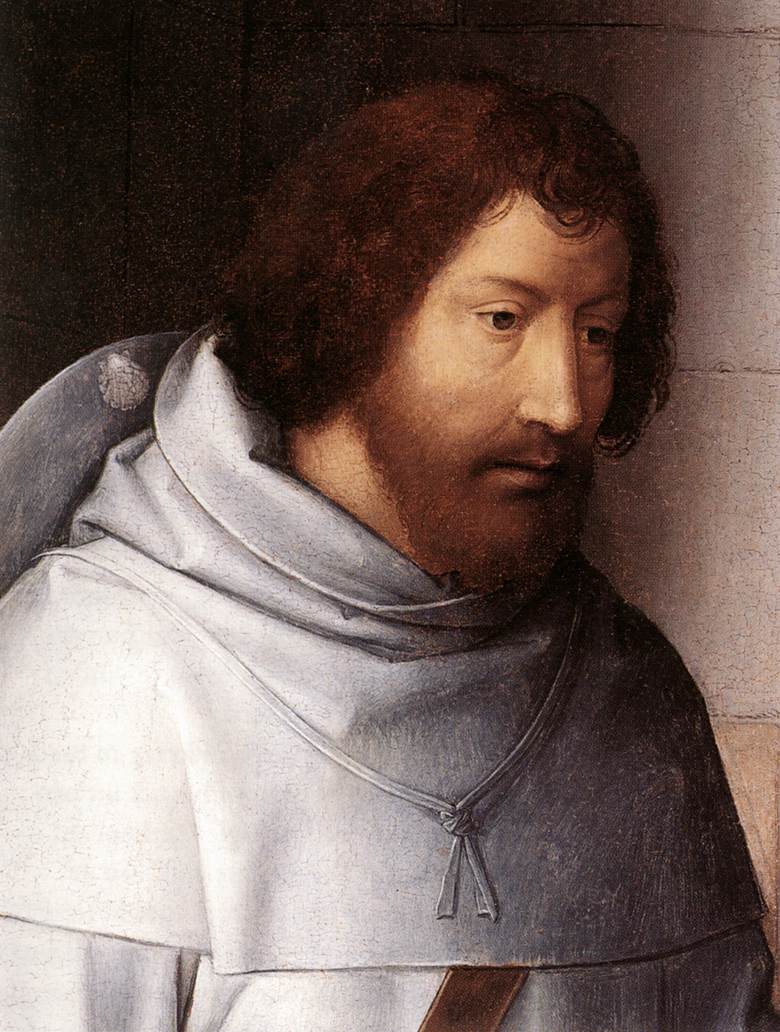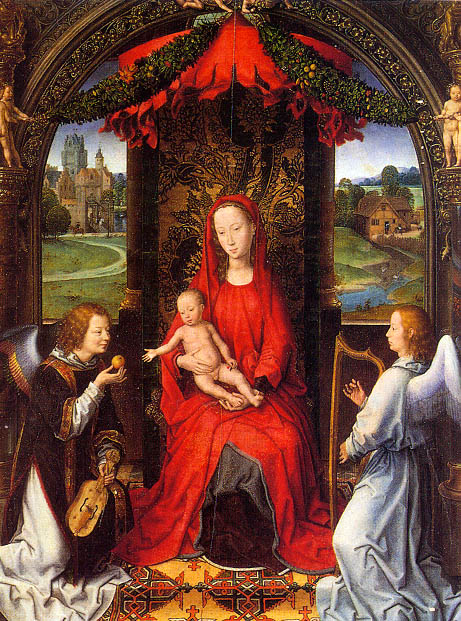Hans Memling
From Wikipedia, the free encyclopedia
Virgin with Child between St. James and St. Dominic (1488-1490). This painting features a Memling carpet.[1]
Contents |
Life and works
Born in Seligenstadt, near Frankfurt in the Middle Rhein region, it is believed that Memling served his apprenticeship at Mainz or Cologne, and later worked in the Netherlands under Rogier van der Weyden (c. 1455–1460). He then went to Bruges around 1465.There is a story (perhaps apocryphal) that he was wounded at the Battle of Nancy, sheltered and cured by the Hospitallers at Bruges and that to show his gratitude he refused payment for a picture he had painted for them. Memling did indeed paint for the Hospitallers in 1479 and 1480 and it is likely that he was known to the patrons of St John prior to the Battle of Nancy.
Memling's name appears on a list of subscribers to the loan raised by Maximilian I of Austria, to defend against hostilities towards France in 1480. In 1477, when he was incorrectly claimed to have been killed, he was under contract to create an altarpiece for the gild-chapel of the booksellers of Bruges. This altarpiece is now in the Galleria Sabauda of Turin. It is one of the fine creations of his more mature period. It is not inferior in any way to those of 1479 in the hospital of St. John, which for their part are hardly less interesting as illustrative of the master's power than The Last Judgment, which since the 1470s, is in the National Museum, Gdańsk. Critical opinion has been generally unanimous in assigning this altarpiece to Memling. This is evidence that Memling was a resident of Bruges in 1473; for the Last Judgment was likely painted and sold to a merchant at Bruges, who shipped it there on board of a vessel bound to the Mediterranean which was captured by Danzig privateer Paul Beneke in that very year. The purchase of his pictures by an agent of the Medici demonstrates that he had a considerable reputation.
It is characteristic that the oldest allusions to pictures connected to Memling point to relations with the Burgundian court. The inventories of Margaret of Austria, drawn up in 1524, allude to a triptych of the God of Pity by Roger van der Weyden, of which the wings containing angels were by "Master Hans". For ages Roger van der Weyden was acknowledged as an artist of the school of Bruges, until records of undisputed authenticity demonstrated that he was bred at Tournai and settled at Brussels. Nothing seems more natural than the conjunction of his name with that of Memling as the author of an altarpiece, since, though Memling's youth remains obscure, it is clear from the style of his manhood that he was taught in the painting-room of Van der Weyden. Nor is it beyond the limits of probability that it was Van der Weyden who received commissions at a distance from Brussels, and first took his pupil to Bruges, where he afterwards dwelt.
The clearest evidence of the connection of the two masters is that afforded by pictures, particularly an altarpiece, which has alternately been assigned to each of them, and which may be due to their joint labours. In this altarpiece, which is a triptych ordered for a patron of the house of Sforza, we find the style of Van der Weyden in the central panel of the Crucifixion, and that of Memling in the episodes on the wings. Yet the whole piece was assigned to the former in the Zambeccari collection at Bologna, whilst it was attributed to the latter at the Middleton sale in London in 1872.
His painting of the Baptist in the gallery of Munich, done circa 1470, is the oldest form in which Memling's style is displayed. The subsequent Last Judgment in Gdánsk shows that Memling preserved the tradition of sacred art used earlier by Rogier van der Weyden in the Last Judgment of Beaune. Memling is seen to have purged his master's manner of excessive stringency, and add to his other qualities a velvet softness of pigment, a delicate transparency of colors, and yielding grace of slender forms. Picture-fanciers of Italy were certainly familiar with the beauties of Memling's compositions, as shown in the preference given to them by such purchasers as Cardinal Grimani and Cardinal Bembo at Venice, and the heads of the house of Medici at Florence.
Triptych of Earthly Vanity and Divine Salvation (front) (c.1485)
Oil on oak panel, 22 x 15 cm (each wing) Musée des Beaux-Arts de Strasbourg
Oil on oak panel, 22 x 15 cm (each wing) Musée des Beaux-Arts de Strasbourg
Advent and Triumph of Christ (or Seven Joys of Mary).
The masterpiece of Memling's later years, the Shrine of St Ursula in the museum of the hospital of Bruges, is fairly supposed to have been ordered and finished in 1480. The delicacy of finish in its miniature figures, the variety of its landscapes and costume, the marvellous patience with which its details are given, are all matters of enjoyment to the spectator. There is later work of the master in the St Christopher and Saints of 1484 in the academy, or the Newenhoven Madonna in the hospital of Bruges, or a large Crucifixion, with scenes from the Passion, of 1491 from the Lübeck Cathedral (Dom) of Lübeck, now in Lübeck's St. Annen Museum. Near the close of Memling's career he was increasingly supported by his workshop. The registers of the painters' guild at Bruges give the names of two apprentices who served their time with Memling and paid dues on admission to the guild in 1480 and 1486. These subordinates remained obscure.
He died in Bruges. The trustees of his will appeared before the court of wards at Bruges on 10 December 1495, and we gather from records of that date and place that Memling left behind several children and considerable property.
Critical opinion
Erwin Panofsky in his 1953 Early Netherlandish Painting (p. 347), says of Memling: "...while the Romantics and the Victorians considered his sweetness the very summit of Medieval art, we feel inclined to compare him to a composer such as Felix Mendelssohn: he occasionally enchants, never offends, and never overwhelms. His works give the impression of derivativeness..."Selected works
- "Adam and Eve" (c. 1485), Oil on oak, 69.3 × 17.3 cm (each), Kunsthistorisches Museum, Vienna
- "Adoration of the Magi" (c. 1470), Oil on wood, 96.4 × 147 cm, Museo del Prado, Madrid
- "Advent and Triumph of Christ" (1480), Oil on wood, 81 × 189 cm, Alte Pinakothek, Munich [1]
- "Allegory with a Virgin" (1479–80), Oil on oak panel, 38.3 × 31.9 cm, Musée Jacquemart-André, Paris [2]
- "Angel Musicians" (1480s), Oil on wood, 165 × 230 cm (each panel)[3]
- "Annunciation" (1467–70), Oil on panels. 83.3 × 26.5 cm (each), Groeninge Museum, Bruges [4]
- "Bathsheba" (1485), Oil on wood, 191 × 84 cm, Staatsgalerie, Stuttgart [5]
- "Carrying the Cross" Oil on oak, 58.2 × 27.5 cm, Museum of Fine Arts, Budapest [6]
- "Christ at the Column" (1485–90), Oil on oak panel, 58.8 × 34.3 cm (with original frame), Colección Mateu, Barcelona [7]
- "Christ Giving His Blessing" (1478), Oil on oak panel, 38.1 × 28.2 cm, Norton Simon Museum of Art, Pasadena [8]
- "Christ Giving His Blessing" (1481), Oil on oak panel, 34.8 × 26.2 cm, Museum of Fine Arts, Boston [9]
- "Christ Surrounded by Musician Angels" (1480s), Oil on wood, 164 × 212 cm, Koninklijk Museum voor Schone Kunsten, Antwerp [10]
- "Crucifixion" (detail), Oil on oak, 56 × 63 cm (full panel), Museum of Fine Arts, Budapest [11]
- "Deposition" (left wing of a diptych) (1490s), Oil on oak panel, 538 × 39 cm, Groeninge Museum, Bruges [12]
- "Diptych of Jean de Cellier" (c. 1475), Oil on wood, 25 × 15 cm, Musée du Louvre, Paris [13]
Memling carpets
Memling carpets are a type of early Oriental carpet painted in several Memlings, and named after him. They are characterized by guls with "hooked" lines radiating from a central body, and probably came from Anatolia or Armenia.Fictional portrayals
Memling features as the central character and first-person narrator of Terence Morgan's 2010 novel The Master of Bruges.References
- ^ King, Donald and Sylvester, David eds. The Eastern Carpet in the Western World, From the 15th to the 17th century, p. 57, Arts Council of Great Britain, London, 1983, ISBN 0-7287-0362-9
Further reading
- Borchert, Till-Holger (ed.) (2005). Memling's Portraits. Thames & Hudson. ISBN 0-500-09326-1.
- de Vos, Dirk (1994). Hans Memling: The Complete Works. Harry N Abrams. ISBN 0-8109-3649-6.
This article incorporates text from a publication now in the public domain: Chisholm, Hugh, ed. (1911). Encyclopædia Britannica (11th ed.). Cambridge University Press.


















_1467_1.jpg)
_1467_1_detail10.jpg)
_1467_1_detail11.jpg)
_1467_1_detail13.jpg)
_1467_1_detail12.jpg)
_1467_1_detail14.jpg)
_1467_1_detail1_left_wing.jpg)
_1467_1_detail2.jpg)
_1467_1_detail3.jpg)
_1467_1_detail4.jpg)
_1467_1_detail5.jpg)
_1467_1_detail7.jpg)
_1467_1_detail8.jpg)
_1467_1_detail9.jpg)















































































































.jpg)


.jpg)

.jpg)

.jpg)
.jpg)
Post a Comment